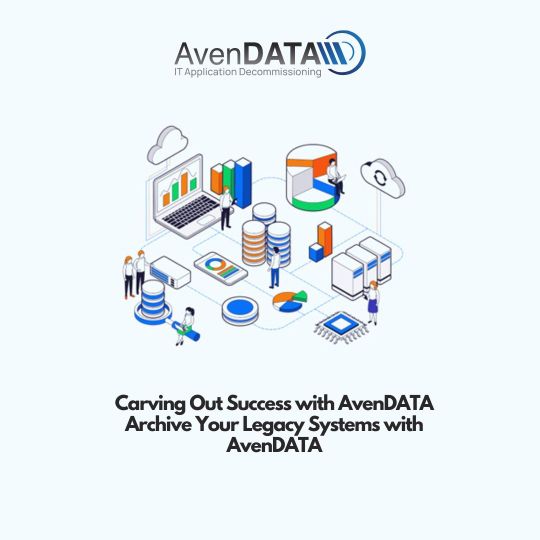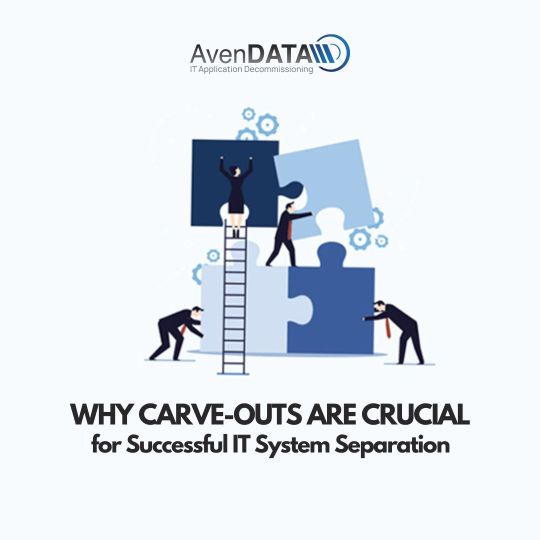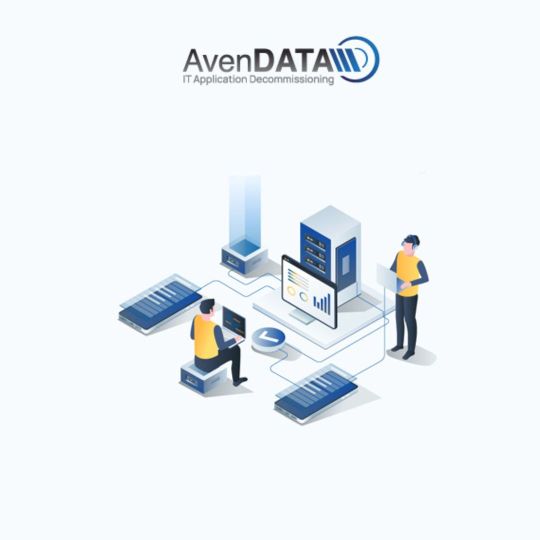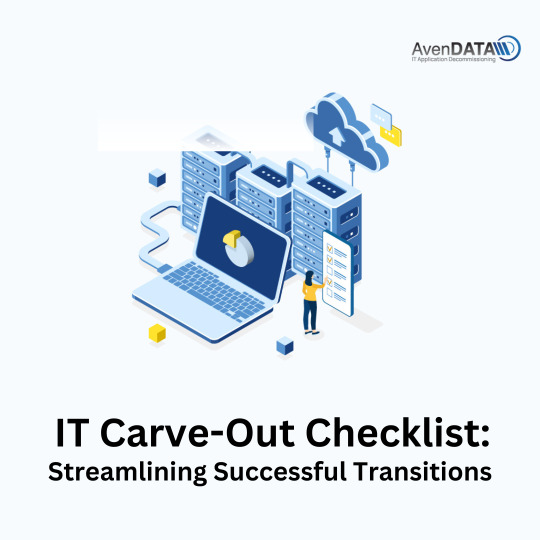Text
What is an SAP Data Carve Out?
An SAP data carve-out involves separating specific data sets, modules, or business units from an existing SAP system to form a new, independent entity. This ensures the new entity operates independently while maintaining data integrity and business continuity.
0 notes
Text

What is an SAP Data Carve Out?
Understanding SAP Carve Out: Definition and Key Concepts
An SAP data carve-out involves separating specific data sets from an existing system to create a new, independent entity. This process involves defining scope, assessing the current environment, planning data migration, executing data extraction, transforming and cleaning, loading data into the new system, ensuring system configuration, conducting comprehensive testing, and providing post-migration support.
Click below to Read the full article:-
0 notes
Text
What is an SAP Data Carve Out?
Understanding SAP Carve Out: Definition and Key Concepts
Click here to Read the full article:-
0 notes
Text
What is an SAP Data Carve Out?

An SAP data carve-out involves separating specific data sets, modules, or business units from an existing SAP system to form a new, independent entity. This ensures the new entity operates independently while maintaining data integrity and business continuity.
Step 1: Define Scope and Objectives
Identify the Scope: Determine which business units, processes, and data sets will be carved out.
Set Objectives: Establish clear goals, such as improving efficiency or preparing for a merger.
Step 2: Assess the Current SAP Environment
Inventory Analysis: Analyze the current SAP environment, including data and interfaces.
Data Mapping: Map data flows and dependencies across modules and processes.
Step 3: Plan the Data Migration
Migration Strategy: Develop a detailed strategy, outlining steps, tools, and resources.
Timeline and Milestones: Create a timeline with clear milestones and deadlines.
Step 4: Execute Data Extraction
Data Extraction Tools: Use SAP Data Services or ETL tools to extract data.
Data Validation: Perform initial validation to ensure accuracy and completeness.
Step 5: Data Transformation and Cleansing
Data Transformation: Adapt data formats and structures to fit the new environment.
Data Cleansing: Remove duplicates, correct errors, and standardize data.
Step 6: Load Data into the New System
Data Loading: Use ETL tools to load data into the new SAP environment.
System Configuration: Ensure the new system is configured correctly.
Step 7: Comprehensive Testing
Functional Testing: Ensure business processes and transactions work correctly.
Performance Testing: Test system performance to identify bottlenecks.
Step 8: Go-Live and Post-Migration Support
Go-Live Plan: Execute the plan, including final data synchronization.
Post-Migration Support: Provide support to resolve issues after going live.
Conclusion
Successfully carving out data in SAP systems requires meticulous planning, thorough execution, and ongoing support. Following these steps ensures a smooth transition, maintaining data integrity and operational continuity.
AvenDATA, a leader in legacy systems archiving and SAP system decommissioning, offers the expertise and tools to navigate SAP data carve-outs, ensuring flawless execution and strategic benefits for your business.
0 notes
Text
AvenDATA offers expert support in carve-outs, focusing on database structures and ERP systems like SAP, Oracle, and Navision. They provide comprehensive solutions for separating clients and accounting areas, adhering to strict timelines and adhering to contractual regulations. AvenDATA's specialized archiving solutions mitigate risks and ensure a smooth transition for employees. Their proven process includes detailed analysis, thorough checklists, and best practices. AvenDATA is dedicated to effective communication and project success.
0 notes
Text
0 notes
Text
Carving Out Success with AvenDATA

Archive Your Legacy Systems with AvenDATA
In recent years, many companies have looked to carve out non-core business units to focus on their primary strengths, reduce debt, and improve earnings. However, the carve-out process is far from simple—it’s filled with risks and complexities. Success in this endeavor hinges on choosing the right solution provider.
AvenDATA excels in this area. We understand the intricacies of carving out company codes and offer expert support in designing, planning, and implementing carve-outs.
Why Choose AvenDATA?
Expertise and Experience: Carve-outs require a deep understanding of database structures and ERP systems like SAP, Oracle, and Navision. Our team possesses the necessary skills and experience to handle these tasks efficiently.
Comprehensive Solutions: We provide a complete solution for separating clients and accounting areas within the ViewBox, which helps avoid legal conflicts over data provision before sales. Our ViewBox can be deployed on-premises or as a secure cloud solution.
Structured Approach: We follow a systematic process to separate elements effectively and efficiently, whether due to company sales, acquisitions, or restructuring (such as S/4 HANA implementations). We adhere to strict timelines to comply with contractual regulations.
Tackling Challenges Head-On
The complexity of carve-outs often arises when acquiring or selling a company. Transferring data between IT systems is fraught with challenges, from asset management and cost forecasting to creating financial statements and handling legalities.
Addressing Employee Concerns: Transitioning employees who are familiar with existing systems can be tricky, as they might feel marginalized. Our solutions are designed to ease this transition with high professional and technical understanding.
Managing Complex Operations: With factors like asset management, legal and tax issues, and financial advisory, carve-outs can be risky. AvenDATA’s specialized archiving solutions mitigate these risks, ensuring a smooth and effective process.
Our Proven Process
We approach carve-outs with meticulous planning and execution:
Detailed Analysis: We start by analyzing systems and data streams to develop a concept that differentiates IT resources between infrastructure and applications.
Thorough Checklists: Our checklists identify dependencies between IT tasks and overall requirements, ensuring a successful data separation.
Best Practices: Our team follows best practices, leveraging our deep understanding of databases to build a thorough strategy and carefully consider deployment options.
Commitment to Success
AvenDATA is dedicated to effective communication and active participation with your IT team. We propose and follow appropriate methods to ensure balanced knowledge dissemination and project success. Our extensive experience in data migration, security management, and data integration makes us the ideal partner for your carve-out needs.
With AvenDATA, you can confidently navigate the complexities of carving out non-core business units and focus on what you do best. Let us help you archive your legacy systems and carve out a path to success.
0 notes
Text
Why Carve-Outs are Crucial for Successful IT System Separation
Carve-outs are crucial for successful IT system separation, as they allow a parent company to focus on its core business while allowing the new entity to establish itself. Key challenges include project management, data migration, process complexity, and system replacements. Two principal factors for successful IT separation are the implications for IT and the role of Transitional Service Agreements (TSA). A well-executed carve-out strategy ensures a smooth and efficient IT separation.
Want to know more about this topic, click below link:-
0 notes
Text
0 notes
Text

Why Carve-Outs are Crucial for Successful IT System Separation
Want to know more about this topic, click below link:-
0 notes
Text
Why Carve-Outs are Crucial for Successful IT System Separation

In today's challenging economic climate, many companies are making tough decisions to stay afloat. One significant strategy is the carve-out of IT units, especially for businesses where IT isn't a core operation. This blog explores why carve-outs are a critical factor in the successful separation of IT systems.
What is a Carve-Out?
A carve-out is a process where a company divests part of its operations, often forming a new subsidiary, joint venture, or completely independent entity. This strategy helps the parent company focus on its core business while allowing the new entity to establish itself.
Why Carve-Outs Matter in IT Separation
IT separation involves detaching IT assets from the parent company while maintaining business continuity. As IT has become integral to business operations, having a solid plan for IT separation during carve-outs is essential.
Key Challenges in IT Separation During Carve-Outs
Project Management: Managing the IT separation project efficiently.
Data Migration: Ensuring smooth data transfer to the new entities.
Process Complexity: Handling the intricacies of the separation process.
System Replacements: Deciding if new IT systems are needed.
Two Principal Factors for Successful IT Separation
Implications for IT During a Carve-Out
Transitional Service Agreement (TSA)
Implications for IT During a Carve-Out
Understanding the implications for IT is vital for a smooth transition. Here are some common considerations:
Separation of Assets: Splitting physical assets like phones, servers, and network connections.
Transition of Systems: Developing a plan to ensure seamless system transitions.
Software Licenses: Arranging for software licenses to be transferred or temporarily used by the new entity.
The Role of Transitional Service Agreements (TSA)
A TSA is a contract between the parent company and the new entity, outlining the services provided during the transition period. This agreement ensures continuity while the new entity sets up its IT infrastructure. Key elements of a TSA include:
Provision of temporary software licenses.
Transition plans for customers, suppliers, and third parties.
Segregation of shared infrastructure and assets.
Support agreements from third-party vendors.
Data transfer plans, including cloud systems.
Smooth handover of help desk and security services.
Transition of custom software features, such as z-transactions in SAP.
Conclusion
A well-executed carve-out strategy is crucial for the successful separation of IT systems. Understanding the implications and having a robust TSA in place are key to navigating the complexities of the process. By addressing these factors, companies can ensure a smooth and efficient IT separation, setting both the parent company and the new entity up for success.
0 notes
Text
Roadmap for Successful Carve-Out Projects
Click below link to know more Carve-Out:-
0 notes
Text
0 notes
Text

Roadmap for Successful Carve-Out Projects
Click below link to know more Carve-Out:-
0 notes
Text
Roadmap for Successful Carve-Out Projects

Mergers and acquisitions (M&A) are pivotal for business growth, often involving the acquisition of companies offering similar products or services. Another strategy is acquiring a unit or division from another company through a divestiture. This process, known as a carve-out, involves partially divesting a business unit, subsidiary, or division while the parent company retains equity and shares in the profits. Here’s a detailed roadmap to understand and navigate successful carve-out projects.
Understanding Carve-Outs
A carve-out is a strategic decision to divest part of a business while retaining some level of control. This allows the parent company to benefit from the profits of the divested unit while addressing strategic goals. Let’s explore the reasons, types, and benefits of carve-outs.
Reasons for a Carve-Out
Several factors make carve-outs an attractive strategy:
Capitalization from Divestment: When a unit is not part of the core business or underperforming, a carve-out allows the parent company to retain equity and continue earning profits.
Stability for the New Entity: The new company can stabilize before being fully exposed to competitive markets.
Creation of New Shareholders: Shares in the subsidiary may be sold to the public, creating a new shareholder base.
Capital Gains Savings: Compared to a full sale or an IPO, carve-outs can result in savings on capital gains taxes.
Types of Carve-Outs
Carve-outs generally fall into two categories:
Equity Carve-Out
Description: Involves selling ownership shares in the subsidiary, providing immediate cash flow.
Used By:
Companies needing immediate cash for operations but planning complete divestiture later.
Companies unable to find a single buyer for the entire unit.
Companies wishing to retain some control over the subsidiary.
Spin-Off
Description: The divested unit becomes an independent business, with its own shareholders and management. The parent company may retain some shares.
Used By:
Companies looking to create a separate entity without selling ownership to a third party.
How Carve-Outs Work
A carve-out separates a subsidiary or division from its parent company while ensuring that the parent retains control, equity, and profit-sharing. This involves selling some equity in the divested unit to outside investors.
Benefits of Carve-Outs in M&A
Considering a carve-out during M&A offers significant advantages:
Operational Efficiency: The acquiring company benefits from the existing infrastructure and workforce of the divested unit.
Capability Enhancement: The acquisition of a functioning unit adds to the acquirer’s capacity.
Support During Transition: The parent company continues to support operations during the transition, facilitating smoother integration with the acquiring company’s infrastructure.
IT and Data Carve-Outs
A critical aspect of carve-outs is the IT carve-out, which involves separating data, software licenses, and other IT assets. This process is essential for ensuring that the new entity can operate independently while maintaining continuity and compliance.
Advantages of Carve-Outs
Carve-outs offer numerous benefits:
Capitalization and Retained Control: Allows the parent company to capitalize on non-core divisions while retaining control and profit-sharing.
Competitive Advantage: By retaining control, the parent company ensures that competitors do not gain an undue advantage.
Stability: Provides a transition period during which the parent company supports the new entity, ensuring stability.
Tax Savings: Potential savings in capital gains taxes compared to outright sales or IPOs.
Conclusion
Carve-outs provide substantial advantages, including retained equity, control, and profit-sharing for the seller, while offering the buyer a functioning unit with existing infrastructure and support. When executed effectively, carve-outs can significantly contribute to the success of M&A activities, providing a strategic pathway for corporate growth.
AvenDATA, as a legacy systems archiving expert, understands the complexities involved in carve-outs and offers tailored solutions to ensure seamless transitions and successful outcomes. Whether it's managing data migrations or ensuring compliance, AvenDATA is your trusted partner in navigating the intricacies of carve-out projects.
0 notes
Text

IT Carve-Out Checklist: Streamlining Successful Transitions
Want to know more about IT Carve-Out, Click below the link:-
0 notes
